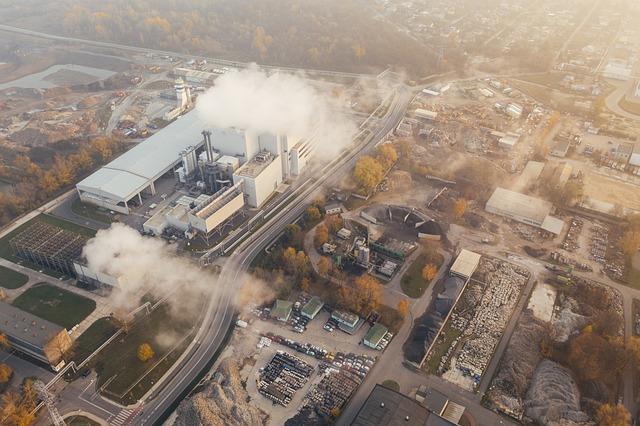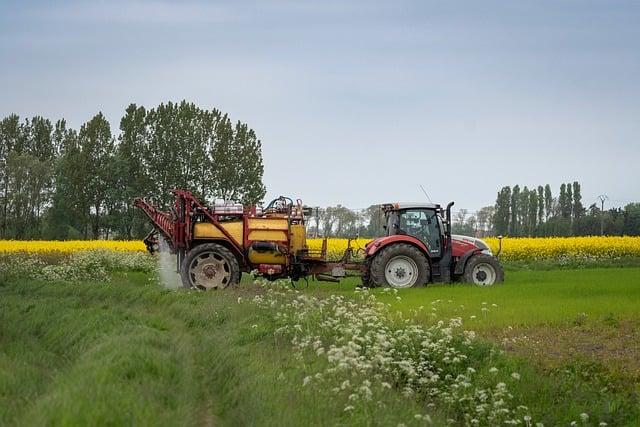As weather exchange escalates and atmospheric prerequisites evolve, the consequences for agricultural productiveness are changing into more and more pronounced, in particular in susceptible areas like East Africa. In Uganda, a rustic closely reliant on its agricultural sector, contemporary analysis has published a troubling correlation between ozone air pollution and the yield hole for bean plants—a staple meals supply and essential element of the nationwide economic system. This text delves into the findings defined in a pivotal learn about printed on Nature.com, which highlights how emerging ranges of ground-level ozone now not handiest impair bean yields but in addition compound the consequences of present agricultural stresses comparable to drought, pests, and soil degradation. Working out the interconnectedness of those environmental demanding situations is an important for creating efficient methods to reinforce meals safety and sustainably set up agricultural programs in Uganda and past.
Ozone Air pollution’s Affect on Bean Yields in Uganda
Ozone air pollution is rising as a crucial issue contributing to the rural yield hole, in particular for bean plants in Uganda. As a key staple within the area, beans play a very important position in meals safety and the native economic system. Then again, research have proven that increased ranges of ground-level ozone can significantly impede photosynthesis and plant expansion, resulting in diminished yields. The affect of ozone is compounded via different agricultural stresses comparable to drought and pest infestations, growing a posh internet of demanding situations that farmers will have to navigate. The interplay between ozone air pollution and those stresses can exacerbate the vulnerabilities of bean plants, restricting their resilience and productiveness.
The results of ozone on beans can also be noticed thru a number of physiological responses, comparable to leaf harm, stunted expansion, and reduced seed high quality. Those adjustments now not handiest impact the amount of beans produced but in addition their dietary price. Components contributing to this air pollution come with business emissions, automobile exhaust, and biomass burning, all of which might be rampant in Uganda. The next desk illustrates one of the crucial key results of ozone air pollution on bean plants:
| Impact | Description |
|---|---|
| leaf Harm | Reasons chlorosis and necrosis, decreasing photosynthetic capability. |
| Stunted Expansion | Limits total plant peak and biomass accumulation. |
| Deficient Seed High quality | Ends up in decrease germination charges and dietary deficiencies. |
| Reduced Yield | ends up in a vital loss in total manufacturing, impacting meals safety. |

Working out the Co-Incidence of Agricultural Stresses
The interplay of quite a lot of environmental elements considerably affects agricultural productiveness, in particular for plants like beans in Uganda. Fresh findings have known ozone air pollution as a an important stressor that exacerbates yield gaps, without delay influencing plant well being and expansion. Then again, ozone does now not act on my own; it steadily coincides with different stressors comparable to drought, nutrient deficiencies, and pests. this co-occurrence creates a posh internet of demanding situations for farmers, making it very important to know the way those elements interrelate and compound their results on crop yields.
For example the multifaceted nature of agricultural stresses, the next desk supplies a snapshot of primary stressors affecting bean manufacturing throughout diffrent areas in Uganda:
| Rigidity Issue | Description | Affect on Yield |
|---|---|---|
| Ozone Air pollution | Destructive gasoline that inhibits plant photosynthesis. | Reduces total plant well being, resulting in decrease yields. |
| Drought | loss of ok water provide all the way through an important expansion levels. | Significantly limits crop expansion and building. |
| Nutrient Deficiencies | Inadequate ranges of very important vitamins in soil. | Ends up in deficient plant vigor and reduced yields. |
| Pest Infestation | Invasion of plants via destructive bugs or pathogens. | Reasons direct harm to crops, additional reducing yield attainable. |
addressing those intertwined stressors calls for built-in control approaches that toughen resilience in bean farming programs. via adopting lasting practices and using climate-smart agriculture, farmers can mitigate the adversarial results of those agricultural stresses, paving the best way for progressed meals safety and livelihood sustainability in Uganda.

The Position of Environmental Components in Crop Manufacturing
Ozone air pollution poses a vital risk to crop manufacturing, in particular for beans in Uganda, the place the subtle steadiness of agricultural ecosystems is already underneath power from quite a lot of environmental stressors.This air pollutant now not handiest reduces the photosynthetic potency of bean crops but in addition exacerbates the consequences of alternative demanding situations comparable to drought, soil degradation, and pest infestations. The concurrent presence of those stressors can result in a compounding yield hole, considerably impacting the livelihoods of native farmers and meals safety within the area. Working out the intricate interaction between those environmental elements is an important for creating efficient agricultural methods.
Mitigation efforts for crop manufacturing will have to focal point on a multi-faceted way, addressing each ozone ranges and different agricultural stresses. Methods would possibly come with:
- Advanced agricultural practices: Enforcing crop rotation and intercropping to toughen soil fertility and resilience.
- Adoption of resilient crop types: Using genetically changed or hybrid beans which might be proof against adversarial environmental prerequisites.
- Coverage tasks: Imposing stricter emissions rules to cut back total air air pollution.
Moreover, analysis signifies that farmer schooling on sustainable practices and environmental consciousness can additional bridge the yield hole led to via ozone air pollution. A collaborative effort involving governments, NGOs, and the rural sector is very important for growing a powerful framework that now not handiest complements bean manufacturing but in addition fosters a sustainable agricultural environment.

Addressing the demanding situations posed via ozone air pollution in Uganda’s bean cultivation calls for a multi-faceted way that contains sustainable agricultural practices and cutting edge generation. Enforcing crop rotation with ozone-resistant types can lend a hand restore soil health and cut back susceptibility to air pollution. Moreover, built-in pest control (IPM) can also be enhanced to include organic keep watch over strategies, decreasing reliance on chemical insecticides that can exacerbate plant rigidity underneath prime ozone ranges.Farmers will have to additionally prioritize agronomic practices,comparable to optimizing planting dates and adjusting irrigation schedules,to make sure plants obtain ok moisture and vitamins,serving to them face up to ozone harm.
Collaboration between farmers, researchers, and governmental organizations is an important for creating efficient mitigation methods. Organising group coaching techniques on ozone consciousness and its affects can empower native farmers with wisdom and sources. Moreover, tracking programs for ozone ranges, blended with satellite tv for pc knowledge for weather and agricultural stressors, may give real-time insights to farmers, enabling them to make knowledgeable choices relating to crop control. As well as, fostering partnerships with universities and analysis establishments can boost up the improvement of resilient bean types thru genetic analysis, making sure the long-term sustainability of bean manufacturing within the face of escalating environmental pressures.

Coverage Suggestions for Improving Bean Yield Resilience
Addressing the yield hole for beans in Uganda necessitates a multifaceted way. key coverage suggestions come with:
- Strengthening air High quality Laws: Enhanced rules to keep watch over ozone precursors, in particular from business and vehicular emissions, are very important.This coudl contain stricter limits on emissions and selling cleaner applied sciences.
- Selling Sustainable Agricultural Practices: Enforcing agroecological practices that reinforce soil well being and build up resilience to environmental stresses can considerably toughen bean productiveness. Those practices would possibly come with crop rotation, quilt cropping, and natural fertilizers.
- Analysis and Construction: Funding in analysis geared toward creating bean types proof against ozone air pollution and different abiotic stresses will have to be prioritized. Collaborative tasks between executive, universities, and NGOs may just boost up this procedure.
- Farmer Training and Improve: Offering farmers with coaching on built-in pest control, soil conservation tactics, and adaptation methods to deal with the affects of each ozone and weather exchange is an important for sustainable yield development.
The implementation of those suggestions will have to be tracked thru a powerful tracking framework to evaluate their effectiveness. It is necessary that every one stakeholders, together with executive our bodies, agricultural organizations, and native communities, paintings collaboratively to make sure the affect of those insurance policies. A proposed framework for tracking may come with:
| Indicator | Dimension Instrument | Frequency |
|---|---|---|
| Ozone ranges | Air High quality Sensors | Per 30 days |
| bean Yield In keeping with Hectare | Agricultural Surveys | Once a year |
| Farmer Coaching Participation | Enrollment Data | Quarterly |
| Soil Well being Metrics | Soil Trying out Kits | Biannually |

Long term Analysis Instructions to Deal with Yield Gaps in Uganda
To successfully cope with the yield gaps for beans in Uganda, long run analysis will have to focal point on a multidisciplinary way that integrates environmental, agronomic, and socio-economic dimensions. key instructions come with:
- Affect of Ozone Ranges: Investigating long-term atmospheric knowledge to quantify the consequences of ozone air pollution on bean yields and exploring attainable adaptive methods.
- Built-in Pest Control: Growing find out how to mitigate stresses from pests that can be exacerbated via ozone, making sure a holistic method to crop well being.
- Soil Well being Growth: Examining the interplay between ozone and soil prerequisites to toughen nutrient availability and plant resilience.
- Local weather Adaptation Methods: Enforcing climate-resilient agricultural practices that imagine the affects of air pollution on crop productiveness.
Moreover,collaboration with native agricultural stakeholders is an important for tailoring answers to express regional demanding situations. Long term research will have to prioritize:
- Neighborhood Engagement: Involving farmers in analysis tasks to collect firsthand insights and foster adaptive practices.
- Knowledge Sharing Platforms: organising out there databases that bring together findings on ozone air pollution’s results and completed mitigation methods.
- Coverage Framework Construction: Advocating for insurance policies that cope with environmental pollution whilst promoting sustainable agricultural practices.

Key Takeaways
the findings offered on this article underscore the pressing want for built-in methods to deal with ozone air pollution and its escalating affect on agricultural productiveness in Uganda. As demonstrated, the interplay between ozone ranges and different agricultural stresses comparable to drought and pest infestations is exacerbating the yield hole for bean plants, a staple meals supply an important for meals safety within the area. Policymakers, researchers, and farmers will have to collaborate to enforce efficient mitigation measures and adaptive practices that may lend a hand maintain the integrity of Uganda’s agricultural programs. By way of prioritizing sustainable agricultural building and environmental well being, there lies attainable now not handiest to toughen bean yields but in addition to foster larger resilience within the face of more than one stressors difficult the livelihoods of numerous Ugandan farmers. Because the weather continues to modify, addressing the multifaceted factor of ozone air pollution will likely be key to safeguarding the way forward for agriculture in East Africa.
Source link : https://afric.news/2025/02/24/ozone-pollution-contributes-to-the-yield-gap-for-beans-in-uganda-east-africa-and-is-co-located-with-other-agricultural-stresses-nature-com/
Writer : Charlotte Adams
Post date : 2025-02-24 08:37:00
Copyright for syndicated content material belongs to the related Source.



